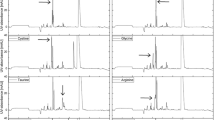Summary
The novel use of capillary electrophoresis to the important and developing area of monitoring possible drug residues on pharmaceutical manufacturing equipment is reported. The CE method is applicable to a wide range of basic drugs with sensitivity as low as 25ng/ml (equivalent to 8×10−8 M). This sensitivity is equivalent to that obtainable for HPLC for the drugs tested and is obtained by employing a combination of a wider bore capillary with low wavelength UV detection. Preliminary evaluation of the method performance shows acceptable precision, linearity, sensitivity and accuracy. Features of the method compared to HPLC include simplicity, ease of method transfer, reductions in analysis set-up time, and reduced costs of solvents and columns.
Similar content being viewed by others
References
S. W. Harder, Pharm. Tech. May, 29, (1984).
D. W. Mendenhall, Drug Dev. and Ind. Pharm.15, 2105 (1989).
M. T. Ackermans, J. L. Beckers, F. M. Everaerts, I. G. J. A. Seelen, J. Chromatogr.,590, 341, (1990).
K. D. Altria, J. Chromatogr.,634, 323, (1993).
K. D. Altria, D. M. Goodall, M. M. Rogan, Electrophoresis,15, 824 (1994).
K. D. Altria, LC.GC Int.,6, (March), 164, (1993).
G. Dinelli, A. Vicari, P. Catizone, J. Agric. Food Chem.,41, 742, (1993).
G. Dinelli, A. Bonetti, P. Catizone, G. C. Galletti, J. Chromatogr.,656, 2759, (1994).
R. J. M. Vervoort, F. A. Maris, H. Hindriks, J. Chromatogr.,623, 207, (1992).
G. L. Chee, T. S. M. Wan, J. Chromatogr.,612, 172, (1993).
K. D. Altria, LG GC. Int.,6 (Oct.), 616, (1993).
P. Coufal, K. Stulik, H. A. Claessens, C. A. Cramers, JHRCC,17, 325, (1994).
C. Schwer, E. Kenndler, Anal. Chem.,63, 1801, (1991).
G. S. Clarke, J. Pharm. Biomed. Analysis,12, 643, (1994).
S. Ryder, J. Chromatogr.,605, 143 (1992).
H. Watzig, C. Dette, J. Chromatogr.,636, 31, (1993).
K. D. Altria, M. M. Rogan, D. M. Goodall, Chromatographia,38, 637, (1994).
Author information
Authors and Affiliations
Rights and permissions
About this article
Cite this article
Altria, K.D., Hadgett, T.A. An evaluation of the use of capillary electrophoresis to monitor trace drug residues following the manufacture of pharmaceuticals. Chromatographia 40, 23–27 (1995). https://doi.org/10.1007/BF02274602
Received:
Revised:
Accepted:
Issue Date:
DOI: https://doi.org/10.1007/BF02274602




